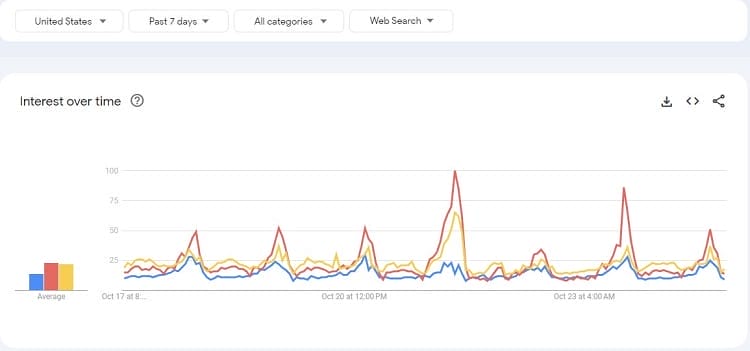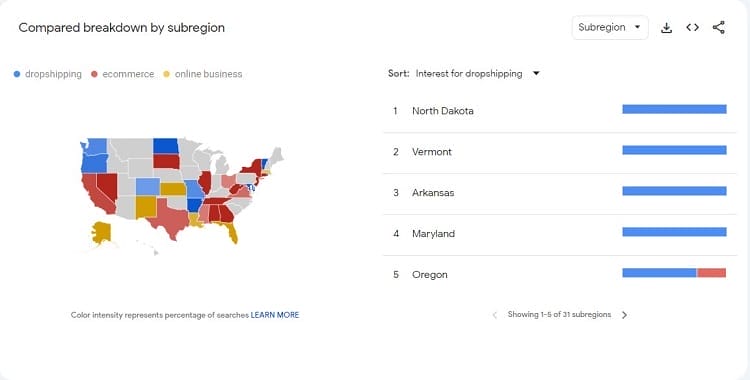Dropshipping, Online Business
Google Trends Dropshipping Guide: What Every ECommerce Seller Needs to Know
- By Moshe
- No Comments
24 Oct

Google Trends Dropshipping Guide: What Every ECommerce Seller Needs to Know
Dropshipping has exploded in popularity in recent years as a lucrative e-commerce model that allows entrepreneurs to sell products without holding inventory. By leveraging dropshipping, online sellers can quickly test products and react to changing market demands. However, identifying profitable niches and hot products to sell can be challenging in the fast-paced world of e-commerce. This is where Google Trends comes in as an invaluable market research tool for drop shippers.
We will explore how dropshipping sellers can utilize Google Trends data to spot lucrative opportunities, understand consumer behavior, adapt to seasonal shifts, and gain a competitive edge. Whether you are just starting in dropshipping or looking to take your business to the next level, leveraging Google Trends should be a key part of your market research and product analysis strategy.
Related Topics:
- Dropshipping vs Affiliate Marketing
- How to grow your dropshipping brand with social media?
- 6 Tools for Dropshippers to gain Insights on competitor
An Introduction to Google Trends
For the uninitiated, Google Trends is a free public web tool by Google that allows users to analyze the popularity of search queries across regions and periods. The search volume data is presented through graphs and charts, which can reveal insightful trends and patterns.
As a drop shipper, Google Trends should be a go-to resource in your arsenal for conducting market research. It can help you identify high-demand products, pinpoint profitable niches, understand consumer interests, adapt to seasonal trends, and much more. By leveraging Google Trends data in your product research process, you can gain an invaluable edge over your competitors.
Key Benefits of Using Google Trends for Dropshipping
Here are some of the key benefits Google Trends provides specifically for e-commerce businesses using a dropshipping model:
- Find lucrative niches and winning products: Identify spikes and trends for search terms to find hot products and untapped niches with less competition.
- Understand consumer behavior: See what people are searching for and are interested in buying right now. This allows you to align your store with customer intent.
- Uncover seasonal patterns: Identify recurring spikes around events, holidays, and seasons to adapt your inventory accordingly.
- Gauge demand and popularity: See search volume patterns for products and categories to identify high-potential opportunities.
- Analyze competitors: Research the seasonality and top terms ranking for competitor websites.
- Optimize marketing campaigns: Align your marketing, advertising, and promotions based on search trends.
- Enhance product listings: Leverage rising search queries in your titles, descriptions, and keywords to boost visibility.
E-commerce sellers have the opportunity to gain valuable insights into consumer demand and market trends by utilizing Google Trends. This allows them to make informed decisions when selecting products that are likely to be successful. Now, let’s explore the process of accessing and navigating Google Trends for dropshipping research.

Launch your own dropshipping store with Importify
Start selling online today without inventory or upfront costs, Importify Connects You to Over 30 Marketplaces with a Single Click.
Getting Started with Google Trends
Google Trends is free to use and does not require any login or account creation. To get started, simply go to [trends.google.com](https://trends.google.com/) and you will reach the Trends homepage. The interface is intuitive and optimized for user research.
Once you access Google Trends, here are some key things you can analyze:
- Track the popularity of a search term over time and observe its increase or decrease in search volume.
- Regional search volume comparison allows you to analyze the popularity of searches across various countries, states, and metro areas.
- Explore additional search queries and concepts that are related.
- Popular search queries are available for lookup.
In the Explore section, you can directly enter up to five search terms, topics, or product names to generate comparative trend graphs. For dropshipping research, this is an excellent starting point to gauge and compare the popularity of product ideas or niche topics.
Analyzing Google Trends Data and Metrics
Now that you understand how to access Google Trends, let’s examine how to interpret the data and metrics it provides for dropshipping research.
- The main graph shows the search volume indexed from 0 to 100 based on the peak popularity of that term over the selected period. A higher score indicates more searches for that term compared to all other points in the timeframe.

- Below the graph, Google Trends displays the most frequently used search terms that are related to your target keyword. This reveals how people search for that product or topic.
- The geographic heatmap shows search volume by country and even states/provinces if you filter for a specific nation like the United States. This allows drop shippers to identify the most lucrative locations to target.

- Google Trends also displays Top Charts – the places, searches, and search topics ranked by search volume for that keyword. Granular location data like cities and states is extremely useful for dropshipping market analysis.
By exploring these different data sets and adjusting date filters, e-commerce sellers can uncover market opportunities and gain critical insights before making product choices.
Conducting Market Research for Your Dropshipping Business
Now that you are familiar with how to use Google Trends and interpret the data, let’s examine how it should be incorporated into your dropshipping market research process. Before investing in inventory, you need to validate the demand and potential for any product. This is where Google Trends comes in handy in multiple ways:
Identifying Profitable Niches
To begin, utilize general keyword themes that are relevant to your interests or business to discover potential niche opportunities that have an increasing search volume and minimal competition. The section labeled “Rising Related Topics” will display new trending searches that have the potential to become profitable niches.
Evaluating Products
To determine consumer demand for specific products, analyzing the search volume and seasonality of keywords is crucial. By observing upward trends and recurring seasonal spikes in search volume, you can identify profitable opportunities. Additionally, the “Related Terms” section displays similar products that are gaining search traction, providing further insights into consumer behavior and preferences. This information can be used to make informed decisions regarding product development, marketing strategies, and inventory management.
Trend Analysis
By studying past search volume patterns, you can identify recurring peaks and troughs. This information is crucial in identifying long-term trends and seasonal spikes that could impact your business. For instance, if your business is related to retail, identifying the peak seasons during which customers are more likely to purchase your products can help you stock up on inventory at specific times. This allows you to cater to the customer’s needs and ensure that you are well-prepared for an increase in demand during certain periods of the year. It also helps in optimizing your marketing efforts as you can target specific keywords or phrases that have higher search volumes during those times.

Demand Forecasting
Data analysis can help businesses make informed projections about product demand during upcoming events, holidays, or important dates. By analyzing past trends, companies can predict surges in specific products around Black Friday, Prime Day, back-to-school season, and other significant occasions. This anticipation can help companies prepare better for increased demand by ramping up production, increasing inventory levels, and planning promotions accordingly.
Competitor Research
Entering competitor URLs can provide valuable insights into the kind of products and content driving traffic to their site. By analyzing their top search terms by volume, you can identify the keywords they are targeting and the topics that are resonating with their audience. This information can help you refine your SEO strategy, identify gaps in your content, and find new opportunities to reach your target audience. Additionally, understanding your competitors’ strengths and weaknesses can help you differentiate your brand and stand out from the crowd.
Capitalizing on Seasonal Google Trends for Dropshipping
As an e-commerce seller, it is crucial to take advantage of seasonal spikes revealed in Google Trends data. Holidays and events like Christmas, Halloween, Valentine’s Day, etc. lead to predictable surges for related products. You need to factor these seasonal trends into your inventory and marketing strategies.
Here are some tips to leverage seasonal Google Trends patterns:
- Stock up in advance on gift items, costumes, decorations, etc. based on data for previous years.
- Create holiday-specific landing pages and email campaigns to capitalize on demand.
- Bid higher on relevant keywords which see increased searches during seasonal spikes.
- Optimize listings with seasonal keywords like “Christmas gifts”, “Halloween costumes” etc.
- Retarget previous customers during the peak season for repeat purchases.
By planning based on seasonal Google Trends data, you can ensure high conversion rates exactly when demand peaks for certain products.
Getting Into The Minds of Customers with Google Trends
One of the most valuable applications of Google Trends for dropshipping businesses is understanding customer intent through search data.
As online searches are a proxy of buying intent, analyzing popular user search queries can provide direct insight into what people want to purchase right now.
Some tips to leverage Google Trends to understand e-commerce consumers:
- See which product variations have rising popularity – “purple iPhone 12” or “hydroflask 24 oz” for instance.
- Identify growing trends like “y2k fashion” or “cottagecore clothes” to curate relevant inventory.
- Adding “buy” or “shop” to search filters surfaces purchasing intent queries – “buy fidget toys”, “shop lounge sets”.
- The “Rising Related Queries” section shows you new trending product searches from consumers.
- Look at geographic trends to see unique product interests specific to states/countries.
To maximize conversions, you can optimize your inventory and marketing by aligning them with the customer journey, as shown in trends data.
Extracting Actionable Insights from Google Trends
While Google Trends provides incredibly valuable data, translating insights into action is key. Here are some ways to convert your Google Trends findings into dropshipping success:
- Curate your product catalog based on rising and trending searches.
- Identify keywords with increasing local search volume to target locally.
- Outsource production for winning products ahead of big seasonal spikes.
- Develop blog content and guides around popular searches to drive organic traffic.
- Create email marketing campaigns focused on trending product categories.
- Improve listings for trending product variations using relevant long-tail keywords.
- Run paid ads to capitalize on short-term trends and seasonal keyword spikes.
The key is to continuously track Google Trends for your top products and categories. Look for actionable patterns in the data and implement changes to your inventory, marketing, and operations.
Best Practices for Leveraging Google Trends for Dropshipping
Here are some top tips to use Google Trends effectively as part of your dropshipping market research and product analysis:
- Track a wide range of relevant keywords including broad terms, long-tail variations, and product-specific searches.
- Look for upward trends signifying growing consumer interest. Avoid fads with only temporary spikes.
- Compare keyword trends by country and region to identify the most lucrative markets to target.
- Analyze trends for both generic and specific product variations. Eg: “yoga mat” and “extra thick yoga mat”.
- Look for recurring seasonal and event-related spikes to forecast winning products.
- Give preference to keywords with higher competition in Google Ads as this signals profit potential.
- Research trends for competitors to find gaps and opportunities in high-demand areas.
- Document your key findings and periodically review past data for long-term pattern analysis.
By following these tips and best practices in addition to the strategies discussed above, drop shippers can gain a data-driven edge by leveraging Google Trends for e-commerce.

Launch your own dropshipping store with Importify
Start selling online today without inventory or upfront costs, Importify Connects You to Over 30 Marketplaces with a Single Click.
Overcoming Challenges with Google Trends
While Google Trends provides invaluable data, it does have some limitations to keep in mind:
- Data is presented in aggregate so may not reflect niche demand accurately.
- Short-term trends and spikes should be validated with other sources before acting.
- Data lags by a few months so cannot reveal hyper-recent rising keywords.
- Results can vary depending on the exact keywords and date range used.
- Rankings are relative so a downward curve may just indicate other rising topics.
The key is to cross-verify Google Trends data with other sources like Google Search results, Google Keyword Planner, and social media trends. Combining quantitative and qualitative research minimizes these limitations.
The Way Forward: Future-Proof Your Dropshipping Business with Google Trends
Google Trends should be an integral part of your dropshipping market research process. By tapping into search volume data and trend analysis, e-commerce sellers can identify promising opportunities, react faster to market shifts, and gain a sustained competitive advantage.
Some potential future applications of Google Trends for dropshipping businesses:
- Integrating Trends data into predictive analytics models to forecast demand.
- Combining insights across Trends and other Google tools like Analytics for deeper customer intelligence.
- Automating inventory alerts and reorders based on Google Trend spike detections.
- Personalization of product recommendations to each user based on location and context Trends data.
The possibilities to leverage Google Trends for dropshipping success are endless, limited only by your imagination. Being proactive about incorporating search insights will enable your business to ride the waves of market changes rather than being swept away by them. So power up your dropshipping efforts today with the free resource that is Google Trends!
Empower your e-commerce journey with insights that matter. Visit Importify’s Blog, your premier destination for exclusive content, trend analysis, and strategic e-commerce know-how. Subscribe today and make informed decisions for tomorrow!
Helping thousands of people to automate their dropshipping business. Skilled in Marketing Management, Advertising, and eCommerce.
Recent Posts
 Successful Dropshipping Techniques To Succeed In Dropshippin…April 15, 2024
Successful Dropshipping Techniques To Succeed In Dropshippin…April 15, 2024 5 Best Practices For Effective Inventory ManagementApril 8, 2024
5 Best Practices For Effective Inventory ManagementApril 8, 2024 How Many Products Should I Start With Dropshipping?April 7, 2024
How Many Products Should I Start With Dropshipping?April 7, 2024 Know the Best Product Research Tools for DropshippingApril 4, 2024
Know the Best Product Research Tools for DropshippingApril 4, 2024 Wix Dropshipping: The Ultimate Guide to Starting a Thriving …April 3, 2024
Wix Dropshipping: The Ultimate Guide to Starting a Thriving …April 3, 2024





Moshe